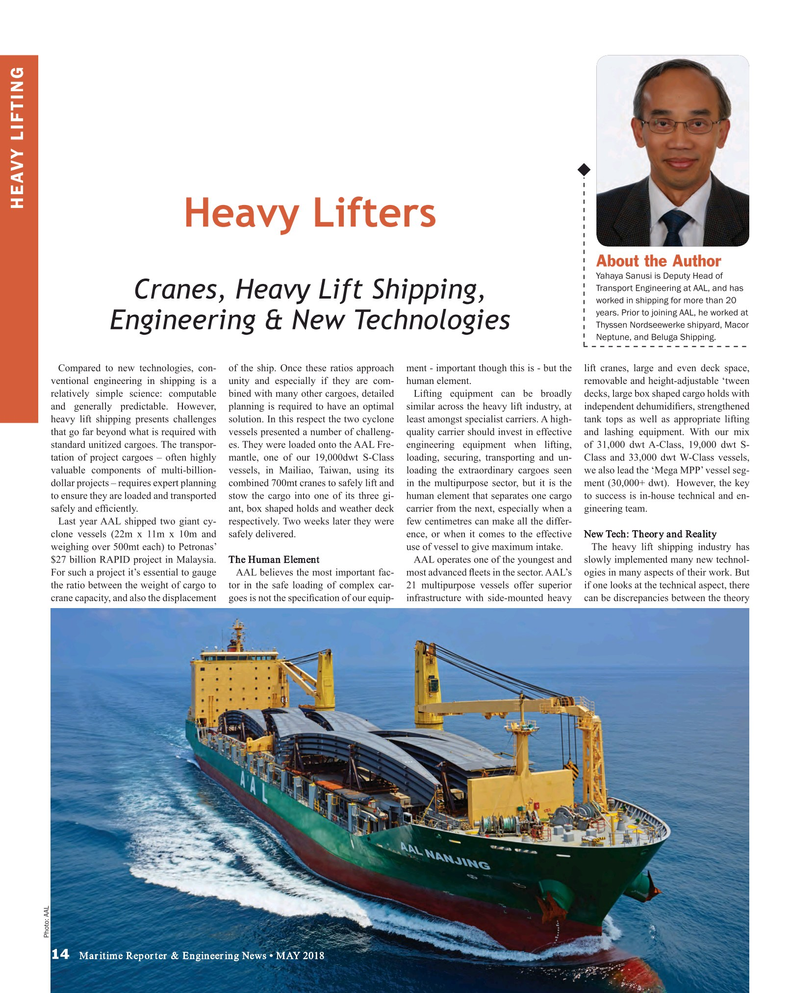
Page 14: of Maritime Reporter Magazine (May 2018)
Marine Propulsion Edition
Read this page in Pdf, Flash or Html5 edition of May 2018 Maritime Reporter Magazine
HEAVY LIFTING
Heavy Lifters
About the Author
Yahaya Sanusi is Deputy Head of
Transport Engineering at AAL, and has
Cranes, Heavy Lift Shipping, worked in shipping for more than 20 years. Prior to joining AAL, he worked at
Thyssen Nordseewerke shipyard, Macor
Engineering & New Technologies
Neptune, and Beluga Shipping.
Compared to new technologies, con- of the ship. Once these ratios approach ment - important though this is - but the lift cranes, large and even deck space, ventional engineering in shipping is a unity and especially if they are com- human element. removable and height-adjustable ‘tween relatively simple science: computable bined with many other cargoes, detailed Lifting equipment can be broadly decks, large box shaped cargo holds with and generally predictable. However, planning is required to have an optimal similar across the heavy lift industry, at independent dehumidi? ers, strengthened heavy lift shipping presents challenges solution. In this respect the two cyclone least amongst specialist carriers. A high- tank tops as well as appropriate lifting that go far beyond what is required with vessels presented a number of challeng- quality carrier should invest in effective and lashing equipment. With our mix standard unitized cargoes. The transpor- es. They were loaded onto the AAL Fre- engineering equipment when lifting, of 31,000 dwt A-Class, 19,000 dwt S- tation of project cargoes – often highly mantle, one of our 19,000dwt S-Class loading, securing, transporting and un- Class and 33,000 dwt W-Class vessels, valuable components of multi-billion- vessels, in Mailiao, Taiwan, using its loading the extraordinary cargoes seen we also lead the ‘Mega MPP’ vessel seg- dollar projects – requires expert planning combined 700mt cranes to safely lift and in the multipurpose sector, but it is the ment (30,000+ dwt). However, the key to ensure they are loaded and transported stow the cargo into one of its three gi- human element that separates one cargo to success is in-house technical and en- safely and ef? ciently. ant, box shaped holds and weather deck carrier from the next, especially when a gineering team.
Last year AAL shipped two giant cy- respectively. Two weeks later they were few centimetres can make all the differ- clone vessels (22m x 11m x 10m and safely delivered. ence, or when it comes to the effective New Tech: Theory and Reality weighing over 500mt each) to Petronas’ use of vessel to give maximum intake. The heavy lift shipping industry has $27 billion RAPID project in Malaysia. The Human Element AAL operates one of the youngest and slowly implemented many new technol-
For such a project it’s essential to gauge AAL believes the most important fac- most advanced ? eets in the sector. AAL’s ogies in many aspects of their work. But the ratio between the weight of cargo to tor in the safe loading of complex car- 21 multipurpose vessels offer superior if one looks at the technical aspect, there crane capacity, and also the displacement goes is not the speci? cation of our equip- infrastructure with side-mounted heavy can be discrepancies between the theory
Photo: AAL 14 Maritime Reporter & Engineering News • MAY 2018
MR #5 (10-17).indd 14 MR #5 (10-17).indd 14 5/4/2018 9:17:41 AM5/4/2018 9:17:41 AM

 13
13

 15
15
